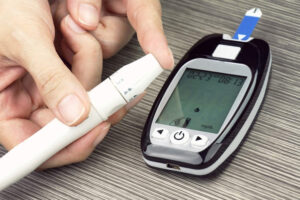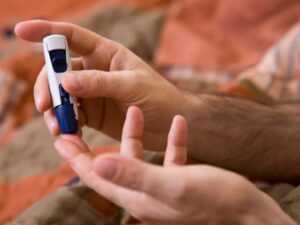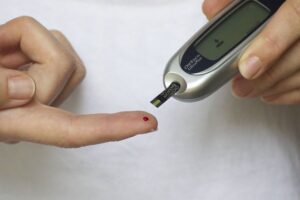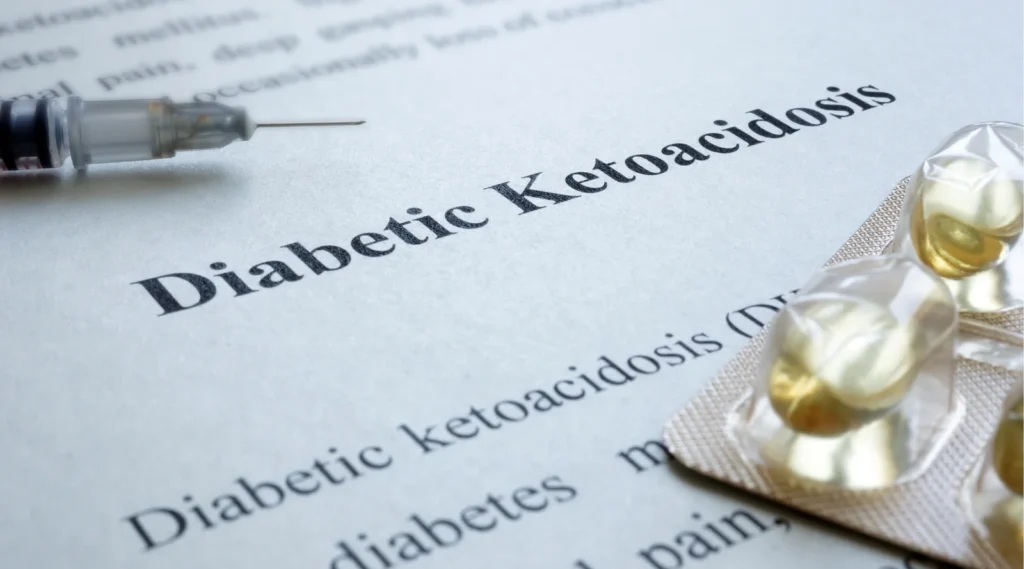Diabetic ketoacidosis (DKA) is a serious complication of diabetes that typically presents with high blood sugar levels. However, a less common variant, euglycemic diabetic ketoacidosis (euDKA), occurs when blood sugar levels remain normal or are only slightly elevated. This condition, although less recognized, poses significant risks and requires prompt medical attention. This guide aims to shed light on euDKA, from understanding its unique characteristics to effective euglycemic DKA treatment strategies.
Contents
What Is Euglycemic DKA?
 Euglycemic diabetic ketoacidosis (euDKA) is a form of diabetic ketoacidosis, a serious diabetes complication. It is characterized by the triad of high ketone bodies in the blood, metabolic acidosis, and normal or mildly elevated blood glucose levels. Unlike the more common form of DKA, which is typically associated with significantly elevated blood sugar levels, euDKA presents with blood glucose levels below 200 mg/dL.
Euglycemic diabetic ketoacidosis (euDKA) is a form of diabetic ketoacidosis, a serious diabetes complication. It is characterized by the triad of high ketone bodies in the blood, metabolic acidosis, and normal or mildly elevated blood glucose levels. Unlike the more common form of DKA, which is typically associated with significantly elevated blood sugar levels, euDKA presents with blood glucose levels below 200 mg/dL.
This can lead to a delay in diagnosis and treatment because the hallmark sign of high blood sugar in DKA is absent. Ultimately, making it a deceptive and potentially dangerous condition. EuDKA shares the same physiological dangers as traditional DKA, including dehydration, electrolyte imbalances, and acidosis. But requires a different approach to diagnosis and management due to its unique presentation.
The condition is particularly noteworthy in individuals with type 1 diabetes. However, it can also occur in those with type 2 diabetes, especially in cases involving reduced food intake, excessive alcohol consumption, or the use of certain medications like sodium-glucose cotransporter 2 (SGLT2) inhibitors.
Do You Give Insulin In Euglycemic DKA?
Yes, insulin plays a critical role in euglycemic DKA treatment. This is similar to its use in classical diabetic ketoacidosis (DKA). Despite the normal or slightly elevated blood glucose levels seen in euDKA, insulin is essential for stopping ketone production and reversing ketoacidosis. The administration of insulin helps to drive glucose into cells. Thereby reducing ketogenesis (the production of ketone bodies) and aiding in the correction of the metabolic acidosis characteristic of DKA.
However, because the blood glucose levels in euDKA are not significantly elevated, insulin therapy must be carefully managed to prevent hypoglycemia. This is a potential side effect of insulin treatment. This often involves a lower dose of insulin compared to classical DKA treatment, coupled with close monitoring of blood glucose and ketone levels. Also, careful adjustment of the insulin dosage is needed.
So, while insulin is a cornerstone of euDKA treatment, the approach is nuanced. Hence, it requires meticulous management to balance the benefits of insulin in reversing ketoacidosis with the risk of causing low blood sugar.
What Are Some Best Euglycemic DKA Treatment Options?
 Euglycemic DKA treatment requires a nuanced approach due to its unique presentation of normal or slightly elevated blood glucose levels alongside ketoacidosis. Here are some of the best euglycemia DKA treatment strategies:
Euglycemic DKA treatment requires a nuanced approach due to its unique presentation of normal or slightly elevated blood glucose levels alongside ketoacidosis. Here are some of the best euglycemia DKA treatment strategies:
Fluid Replacement
Fluid replacement is the cornerstone of euglycemic diabetic ketoacidosis (euDKA) treatment, addressing the critical issue of dehydration that accompanies this condition. The administration of isotonic saline (0.9% sodium chloride) serves to replenish the intravascular volume, supporting circulation and renal perfusion. This step is vital in the initial phase of treatment, where the goal is to restore normal hydration status and correct the circulatory deficit caused by osmotic diuresis due to hyperglycemia and ketonuria.
Electrolyte Management
As insulin therapy is initiated and fluids are administered, close attention to electrolyte levels, especially potassium, is imperative. Insulin promotes the movement of potassium from the extracellular fluid into the cells, potentially leading to hypokalemia if not adequately addressed. Potassium replacement is usually required to prevent cardiac arrhythmias and muscle weakness. The strategy involves continuous monitoring of serum potassium levels and adjusting potassium supplementation based on these levels.
Monitoring and Adjustments
Effective management of euDKA involves meticulous monitoring of clinical and biochemical parameters. This includes frequent assessments of vital signs, urine output, blood glucose, ketone levels, and electrolyte concentrations. The insights gained from continuous monitoring guide the adjustments in fluid, electrolyte, and insulin therapies. For example, if blood glucose levels begin to decrease too rapidly, the rate of insulin infusion may be reduced, or if hypokalemia is detected, potassium supplementation can be increased.
Identification and Treatment of the Underlying Cause
Identifying and addressing the precipitating factor(s) for euDKA is crucial for resolving the acute episode and preventing recurrence. This may involve treating infections, optimizing glycemic control, adjusting or discontinuing medications that may contribute to euDKA (such as SGLT2 inhibitors), and educating patients on the management of their diabetes, especially during illness or stress. Understanding the underlying cause helps tailor the treatment approach to manage the current episode. Also, strategize for long-term prevention.
Patient Education
Education plays a pivotal role in preventing euDKA episodes. Patients, particularly those at higher risk, should be educated about the early signs and symptoms of euDKA, the importance of regular monitoring of blood glucose and ketone levels, and the need to seek immediate medical care if symptoms arise. This education should also cover the management of diabetes medications during illness or other situations that might predispose to euDKA, emphasizing the importance of not discontinuing insulin without medical advice.
Consideration for SGLT2 Inhibitor Therapy
SGLT2 inhibitors have been associated with an increased risk of euDKA, and their use requires careful patient selection and monitoring. The decision to continue, adjust, or discontinue SGLT2 inhibitor therapy should be made on an individual basis, considering the patient’s overall diabetes management plan, risk factors for euDKA, and the potential benefits of the medication in controlling blood glucose levels. This decision-making process highlights the need for personalized diabetes care and ongoing risk-benefit analysis in medication management.
Overall, a multidisciplinary approach involving a team of healthcare professionals, including endocrinologists, emergency medicine doctors, and nurses, is essential for the management of euDKA.
How Can I Prevent Euglycemic DKA?
 Preventing euglycemic diabetic ketoacidosis (euDKA) requires a proactive and comprehensive approach to diabetes management, focusing on both general wellness and specific strategies to minimize the risk of developing this condition. Here are some key prevention tips:
Preventing euglycemic diabetic ketoacidosis (euDKA) requires a proactive and comprehensive approach to diabetes management, focusing on both general wellness and specific strategies to minimize the risk of developing this condition. Here are some key prevention tips:
- Regular Diabetes Management Reviews
Regular check-ups with a healthcare provider can help ensure that your diabetes management plan is effective and up-to-date. These reviews offer opportunities to adjust medication, diet, and exercise plans based on your current health status.
- Illness Management Plan
Having a plan in place for managing your diabetes during illness is crucial. This includes knowing how to adjust your medication (especially insulin), when to increase your fluid intake, and how to monitor your blood glucose and ketone levels more frequently.
- Stress Reduction Techniques
Chronic stress can affect blood glucose levels and overall health, potentially increasing the risk of euDKA. Implementing stress reduction techniques, such as mindfulness, yoga, or regular exercise, can help manage stress and its impact on diabetes.
- Avoiding Excessive Alcohol Consumption
Excessive alcohol consumption can increase the risk of euDKA by causing dehydration, hypoglycemia, and impaired liver function. This can affect glucose production and ketone body metabolism. Moderation in alcohol consumption or abstaining altogether is advisable.
- Nutritional Counseling
Consulting with a dietitian for personalized nutritional advice can help manage diabetes more effectively. A balanced diet that controls blood sugar levels and supports overall health can reduce the risk of euDKA.
- Hydration
Maintaining adequate hydration is important for preventing euDKA, as dehydration can contribute to the development of this condition. Drinking sufficient amounts of water and other fluids, especially in hot weather or during exercise, is essential.
- Wearing a Medical Alert Bracelet
Wearing a medical alert bracelet or carrying an identification card that indicates you have diabetes can be lifesaving in an emergency. It ensures that first responders are aware of your condition and the risk of euDKA. And, allowing for quicker and more effective treatment.
By integrating these preventative measures into daily life, individuals with diabetes can significantly reduce their risk of developing euDKA. Ultimately, improve their overall health and well-being.
Conclusion
In conclusion, euglycemic DKA treatment requires awareness, careful monitoring, and proactive strategies. By staying hydrated, monitoring blood sugar and ketone levels, and working closely with healthcare providers to adjust treatments as needed, individuals can effectively manage their condition. Regular reviews of diabetes management, stress reduction, and avoiding excessive alcohol are also key to preventing euDKA.
Together, these measures can help minimize the risk of euDKA. Hence, ensures better health outcomes for those living with diabetes. Do you want to get rid of diabetes? Join our online diabetes treatment program and reverse Diabetes naturally through lifestyle changes such as a Personalized Diet plan, Exercise, Yoga, dieticians, and health coaches.

